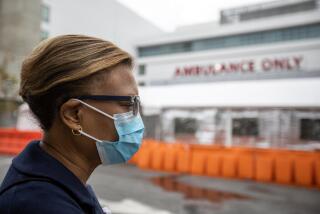Possible Threat to Valley’s Healthcare Cited
The population in the San Fernando Valley is growing while the number of hospitals there is shrinking, a trend that could threaten the region’s healthcare system, economic forecasters said Thursday.
In the next six years, more than 250,000 people are expected to move into the sprawling suburb where 12 of 33 hospitals have closed in the last two decades, experts said.
While some hospitals are expanding, such as Valley Presbyterian Hospital, which will unveil its new state-of-the-art patient-care tower in Van Nuys today, others are not faring as well. The two campuses of Tenet Healthcare Corp.’s Encino-Tarzana Regional Medical Center are for sale and bankrupt Granada Hills Community Hospital closed its doors last year.
As the sixth-largest employer in the Valley -- providing jobs for more than 20,000 people and paying $1.25 billion in wages annually -- the hospital industry represents one of the principal financial sectors of the region’s economy and one of the most challenged, experts said.
Several chief executives from area hospitals and officials from the Economic Alliance of the San Fernando Valley spent the last year discussing economic conditions and prescriptions to restore Valley hospitals to fiscal health.
The alliance chronicled hospital executives’ efforts to manage increased demand, limited resources, budget deficits, labor shortages and regulatory constraints in its “San Fernando Valley Hospital Report 2004,” released Thursday.
“I don’t want to sound like a doomsday forecaster, but after participating in this study and listening to our hospital leaders, I’m here to tell you we’ve got a serious problem,” Economic Alliance President and Chief Executive Bruce Ackerman said at a news conference at the Grossman Burn Center in Sherman Oaks.
According to the report, hospital executives said inadequate reimbursement for the care of uninsured patients and reduced payments for some with insurance have resulted in deficit spending.
The executives also complained that their facilities spent millions of dollars to meet unfunded state and federal mandates -- such as seismic retrofitting, nurse-to-patient staffing ratios and audits and reviews -- but unlike other businesses, could not recover those costs through increased fees, the report said.
A shortage of registered nurses, pharmacists, imaging technicians, physical and occupational therapists, lab technicians, billing clerks and housekeepers has kept hospitals from operating efficiently, the report said.
California’s nurse-to-patient ratio law requires every hospital to be in continuous compliance with government-prescribed staffing standards. Yet, hospital executives said, California ranks next to last in the nation in the number of registered nurses per capita, making it difficult to comply with the law.
“Let’s be clear on this point,” Ackerman said. “Hospitals are not opposed to nursing ratios -- they support safe staffing at all levels -- but when there are not enough nurses in the supply pipeline, how can we comply with arbitrary mandates?”
While the report outlines the challenges hospitals face, it also cites Economic Alliance officials’ initiatives aimed at averting a collapse of the Valley’s healthcare system. The efforts include collaborating with the Valley Industry and Commerce Assn. to press for legislative changes and establishing focus groups to discuss healthcare industry labor shortages.
“In short, we are in a crisis and it’s time the public learns the facts,” Economic Alliance Chairman David Fleming said Thursday.
More to Read
Sign up for Essential California
The most important California stories and recommendations in your inbox every morning.
You may occasionally receive promotional content from the Los Angeles Times.










